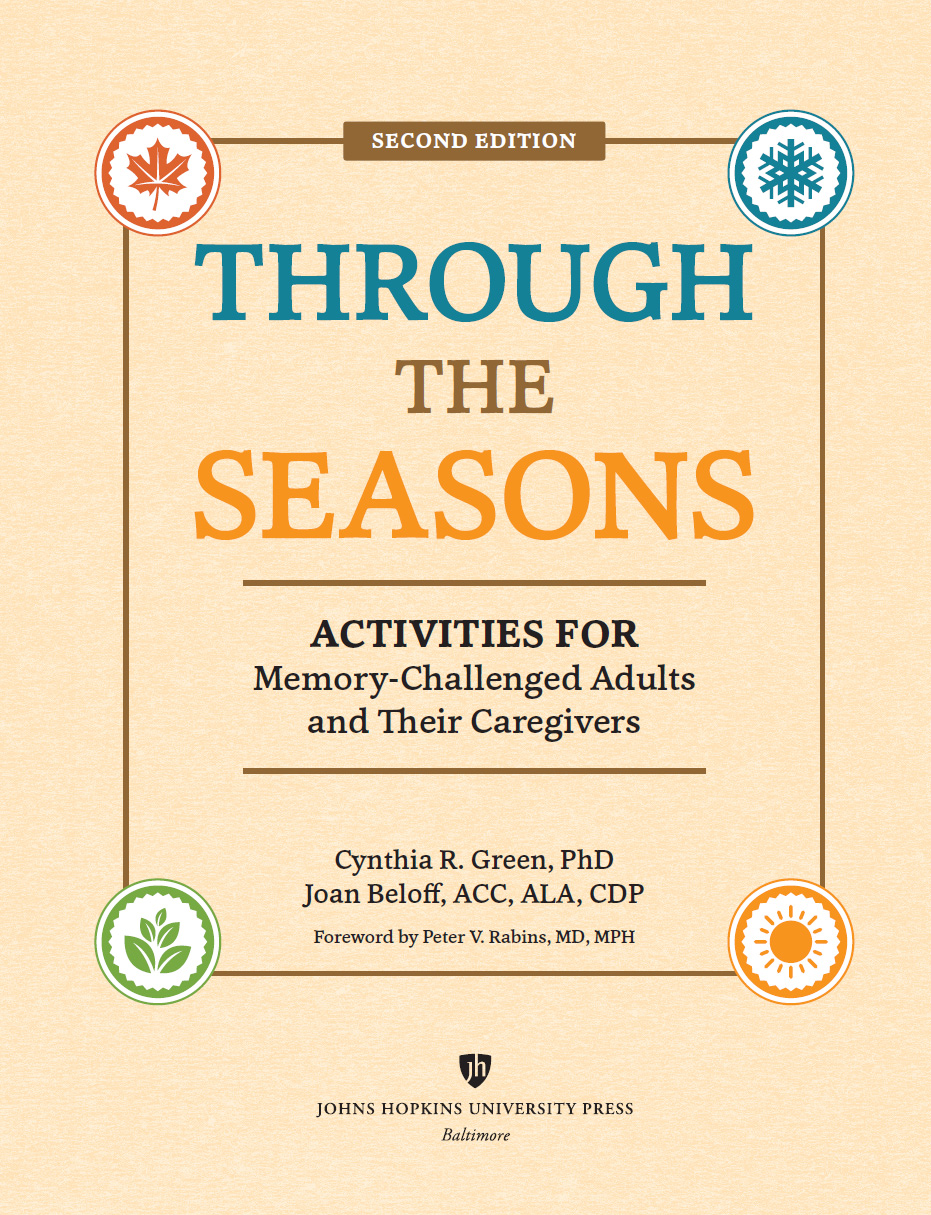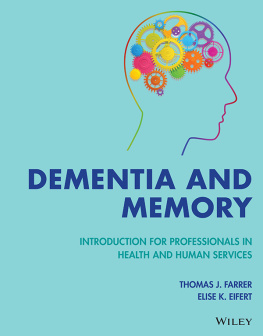Through the Seasons
A Johns Hopkins Press Health Book

2020 Cynthia R. Green and Joan Beloff
All rights reserved. Published 2020
Printed in China on acid-free paper
9 8 7 6 5 4 3 2 1
Johns Hopkins University Press
2715 North Charles Street
Baltimore, Maryland 21218-4363
www.press.jhu.edu
Library of Congress Cataloging-in-Publication Data
Names: Green, Cynthia R., author. | Beloff, Joan, 1953 author.
Title: Through the seasons : activities for memory-challenged adults and their caregivers / Cynthia R. Green, PhD, Joan Beloff, ACC, ALA, CDP ; foreword by Peter V. Rabins, MD, MPH.
Description: Second edition. | Baltimore : John Hopkins University Press, 2020. | Series: A Johns Hopkins Press health book.
Identifiers: LCCN 2019016215 | ISBN 9781421436463 (hardcover) | ISBN 1421436469 (hardcover) | ISBN 9781421436470 (paperback) | ISBN 1421436477 (paperback) | ISBN 9781421436487 (electronic) | ISBN 1421436485 (electronic)
Subjects: LCSH: Memory disordersPatientsRehabilitation. | DementiaPatientsRehabilitation. | Memory disorders in old agePatientsRehabilitation. | Caregivers.
Classification: LCC RC394.M46 G74 2020 | DDC 616.8/3dc23
LC record available at https://lccn.loc.gov/2019016215
A catalog record for this book is available from the British Library.
All photographs are iStockphoto except on the following pages: 23, Susanna Cesareo / Shutterstock.com; 29, Alina Reynbakh / Shutterstock.com; 33, www.YourFleece.com.
Casey at the Bat on .
Special discounts are available for bulk purchases of this book. For more information, please contact Special Sales at 410-516-6936 or .
Johns Hopkins University Press uses environmentally friendly book materials, including recycled text paper that is composed of at least 30 percent post-consumer waste, whenever possible.
To those living with memory challenge and those caring for them. We hope the experiences offered in this book, and those that you find for yourself along the way as you use them, will create moments together that bring joy, meaning, and connection.
FOREWORD
Peter V. Rabins, MD, MPH
W hen I first became interested in the care of people with dementia forty years ago, I read an article by geriatric psychiatrist Dr. Jack Weinberg entitled, What Do I Say to My Mother When I Have Nothing to Say? In it, Dr. Weinberg describes the frustration he experienced when talking with his mother, who was cognitively impaired and living in a long-term facility. To him, these conversations were contrived and repetitive, and he quickly ran out of new things to say. His feelings of frustration and helplessness totally changed once he realized that the most important aspect of talking with his mother was the pleasure she experienced when engaged in a conversation, not the specific content of their conversation.
Dr. Weinbergs realization made his daily talks with his mother much more meaningful for both of them. This insight helped him enjoy their interactions as he had before her illness, and this, in turn, improved her mood and sense of well-being. Reading his article helped me appreciate the importance of maintaining social engagement for people with dementia.
As Cynthia Green and Joan Beloff demonstrate in Through the Seasons, weve learned a lot since Dr. Weinbergs article. Most importantly, perhaps, are the ideas that it does matter what we talk about and do when we interact with people who are experiencing dementia and that it is important to fit the content of verbal interactions and physical activity to the persons abilities and strengths as well as the specifics of their lives. But underlying the approach of Through the Seasons is the insight that Dr. Weinberg experienced: Maintaining meaningful human contact with people experiencing dementia is important no matter how ill they are.
Through the Seasons beautifully balances a discussion of the principles underlying this approach with specific, practical, and reasonable guidance on how to actually do it. With Cynthia Green and Joan Beloffs guidance, staying focused on the primary goal of dementia caremaximizing the quality of life of people with dementiabecomes achievable.
It is easy to underestimate the skill that it takes to reach this goal. What I particularly like about Through the Seasons is that the specificity of its suggestions helps get us over the hump of initiating and sustaining meaningful conversations and activities with people experiencing a range of cognitive disabilities. This is an important first step in developing the skills needed by both the professional care provider and the family caregiver. For the professional, the book provides a range of suggestions, advice, and templatesa roadmap, if you willfor refining their skills and helping them personalize interactions with those they are caring for. For the caregiver of a family member with dementia, Through the Seasons will help get past the barriers identified by Dr. Weinberg as well as help identify the steps they can take to provide the stimulation that is so important for the person with dementias quality of life.
This new edition is notable for its greater emphasis on linking the lifelong experiences of people with dementia to the content of their current interactions. This emphasis on care recipients ethnic and experiential backgrounds as well as their values and wants addresses the worldwide trend of increasing ethnic diversity.
A combination of increasing longevity and increasing emigration means that people with dementia in any single location, and the professionals who are providing their care, are now more diverse than was true in the past. In addition, a worldwide trend towards decreasing family size means that family caregivers will be increasingly unavailable. Through the Seasons provides a needed guide to address these trends.
The thread that ties together the strands of guidance and understanding contained in Through the Seasons is the word joyjoy in those who are experiencing dementia, joy in those who are providing care to them, and the joy and satisfaction that comes from knowing that there are tools available to help those who want to improve the care of people with dementia. By providing a practical guide to helping people achieve the satisfaction that comes from having enjoyable interactions and accomplishing pleasurable tasks, Through the Seasons has played and will continue to play an important role in maximizing quality of life of people with dementia.
PREFACE
I t is difficult to believe that more than a decade has passed since the publication of the first edition of Through the Seasons.
The idea for the book initially arose from our frustration at the time with the quality and tone of the available cognitive-stimulation resources for individuals with memory loss and their caregivers. While the evidence suggested that such programs could be beneficial, much of the material we found was limited and, in many instances, childish and demeaning in approach. It was our intention to provide activities that offered fulfilling engagement while fostering opportunities for continued meaningful connection and communication between those with memory disorders and the families and professionals who cared for them. It has been both gratifying and humbling to hear from the many families and colleagues who have found this collection of activities helpful and inspiring.
Over the past decade, much has changed in the field of dementia care. Among other things, we have seen scientific advances in dementia management, increased acceptance of person-centered approaches to care, and a growing availability of cognitive-stimulation programs for both institutional and home care settings. We are pleased to have the chance to update the original edition of this book to include new information and materials that reflect this progress.
Next page




